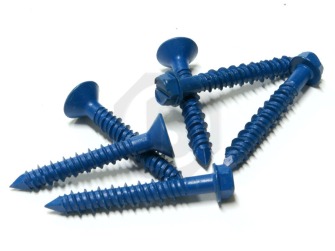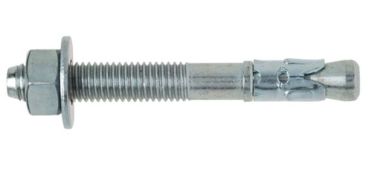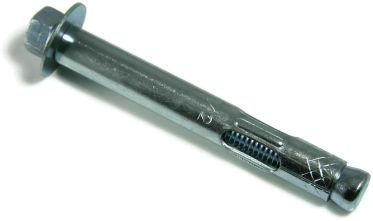Masonry and concrete anchors are used when it’s not possible to insert a screw directly into a masonry structure. The concept of an anchor is typically a two piece unit, the housing and the fastener. The housing is commonly placed securely in a predrilled hole with the fastener being installed after. Masonry anchors are subject to pull in 2 different ways: Shear – downward force that would break or shear the fastener in half, and Tensile – outward force acting to pull the assembly out of the hole. The following are the most common masonry anchor types and their primary functions:
1. Concrete Screws (Other names – Tap-Con, self tapping concrete sccrew, Titon Screw, Masonry Screw) – Light Load Applications such as fastening wood to concrete, etc. They are threaded with either hex washer or flat phillips counter sunk head. These screws are designed to tap threads through masonry into predrilled holes and are commonly installed with an impact driver or hammer drill.

2. Wedge Anchor – (Other Names & Types – Stud Anchor, Qwik-Bolt, Expansion Bolt, Shielded Expansion Anchor) – Heavy Duty load applications such as machinery attachment or structural member attachment. The three types of Expansion anchor’s are fully threaded, partial threaded, and full-bodied. Wedge anchor’s are installed by pre-drilling a hole, hammering the anchor assembly into the hole, and fastening the bolt causing the bolt casing to expand inside the wall making the assembly almost impossible to pull out of the wall. Expansion anchors can be used in concrete, brick, or block. Typical Sizes range from 1/4″ – 3/4″.

2a. Expansion Anchor – A shielded expansion anchor can be used in most masonry materials and can be ‘Single’ or ‘Double’. Single expansion anchors are often used in dense hard materials like red brick. A double expansion anchor would be geared more towards a material with unknown or potentially softer strength because it expands along it’s entire length versus only one end like a single expansion anchor.
Shielded Expansion anchors are also available which can be used with concrete, masonry, and block. They are commonly used in high-load applications.

2.b Sleeve Anchor (Other Names – Lok Bolt) – The only mechanical difference between a sleeve anchor and a wedge anchor is the sleeve component versus a simple wedge component, creating different structural mechanics of the anchored connection. A sleeve anchor is one of the more versatile anchors used in Medium Duty load applications such as anchoring handrails, decks, and shelves. These are made up with threaded rod with one end beveled, a sleeve that goes over the rod, a nut and washer. When the nut is turned, the working end of the sleeve anchor moves outward, expanding the sleeve and anchoring itself to the masonry. These anchors should be used in solid concrete only.

2c. Dropin Anchor – These anchors are made up of a tubular expansion shield and a solid, cone-shaped expander plug. They are commonly used for doweling joints between an existing and proposed slab or structures, but can also be used for structural attachments or suspension of materials. Dropin anchors are not recommended for brick or block applications. The shield commonly has 4 slots on one end and is internally threaded on the opposite end. These are installed by predrilling a hole roughly the same size as the shield and using a setting tool to fasten the shield to the surround concrete. The designated diameter refers to the bolt or threaded rod diameter to be utilized within the shield. The actual predrilled hole will be larger.



